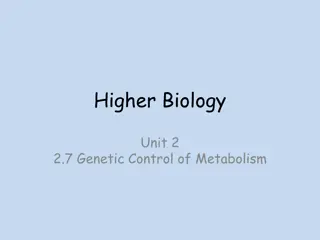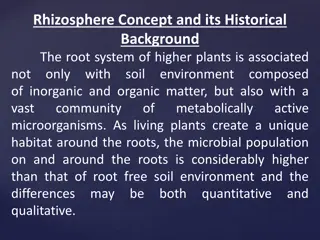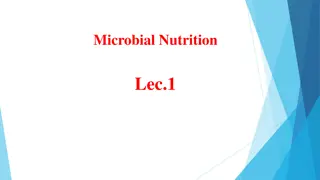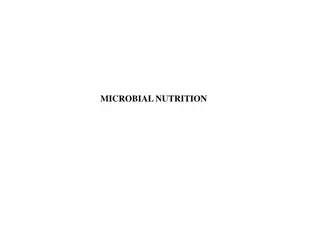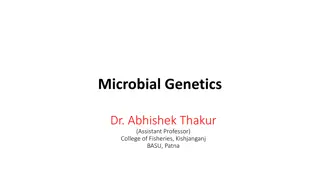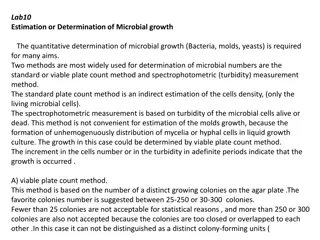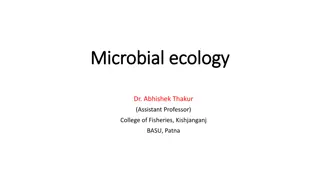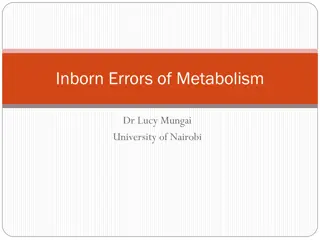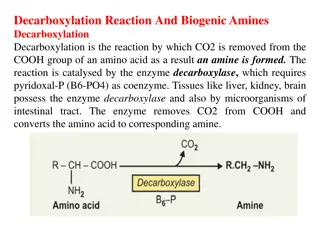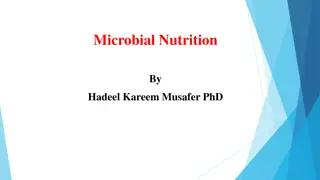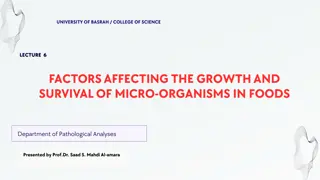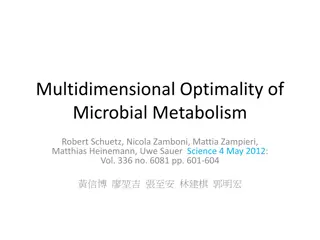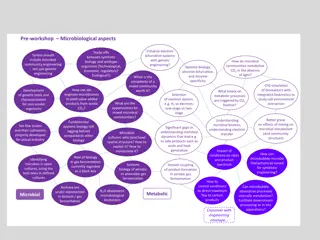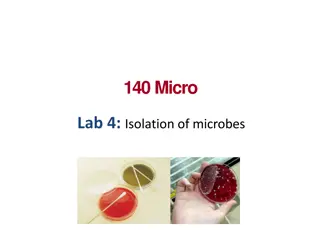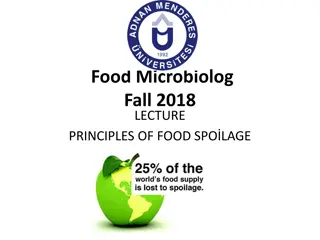
Microbial Metabolism: Energy Flow in Living Systems
Explore the essential role of solar energy in driving living systems, the process of chemical energy transformation by producers, and the significance of bioenergetics in managing energy resources. Dive into the biochemical reactions of metabolism, including catabolism and anabolism, crucial for the synthesis and maintenance of cellular structures.
Download Presentation

Please find below an Image/Link to download the presentation.
The content on the website is provided AS IS for your information and personal use only. It may not be sold, licensed, or shared on other websites without obtaining consent from the author. If you encounter any issues during the download, it is possible that the publisher has removed the file from their server.
You are allowed to download the files provided on this website for personal or commercial use, subject to the condition that they are used lawfully. All files are the property of their respective owners.
The content on the website is provided AS IS for your information and personal use only. It may not be sold, licensed, or shared on other websites without obtaining consent from the author.
E N D
Presentation Transcript
M.S.P. Mandals Deogiri College, Aurangabad Microbial Metabolism B. Sc. T. Y. (2020-21) Semester-V Paper Number-XVI Introduction to Microbial Metabolism By Dr. DEEPTI D. DHERE Assistant Professor Department of Microbiology M.Sc. Microbiology UGC-CSIR NET, MH-SET
Living system Living system needs energy and biomolecules for its persistence The solar energy is the indispensable source of energy for whole living system. In living system solar energy is transformed in to chemical energy by producers (Plants) This chemical energy is made available for rest of ecosystem in different forms Carbon, Hydrogen, oxygen and water are constantly cycled between the heterotrophic and autotrophic worlds Bioenergetics is the study of how organism manages its energy resources. Trapped by the plants Converted in to chemical energy Store energy in the form of chemical bonds e.g. starch Break down sugars Some stored in chemical bonds Solar energy Plants Animals
Chemical Transformations Carbohydrates converted into Sugars Proteins converted to Amino acids Fatsare converted in to Fatty acids Amino acids, Sugarsand Fatty acids are again used for making new molecules
Introduction Definition- All of the biochemical reactions in an organisms collectively called as metabolism. In Greek metabole- change The sum of the total biochemical reactions required for energy generation and the use of energy to synthesize cell material from small molecules in the environment. All living cells depends on biochemical reactions to maintain homeostasis. Homeostasis- In biology, homeostasis is the state of steady internal, physical and chemical conditions maintained by the living system. This is the condition for optimal functioning of the organisms and includes many variables, such as body temperature and fluid balance, being kept in the certain pre-set limit.
Biochemical Reactions There are two types of biochemical reaction which collectively constitutes metabolism. Theses reactions are called as catabolic and anabolic reactions. Catabolism (Degradation- broken down- oxidative) Anabolism (Biosynthetic Built up- reductive) Metabolism (Total Biochemical reactions)
Anabolic reactions These reactions use raw constituents (micro- molecules) and energy to built macromolecules and cellular structures. Reactions that results into building of new molecules These molecules are used for synthetic processes Production of new biomolecules from raw. These are endergonic reactions (Use energy in the form of ATP) The whole process of synthetic reactions through consumption of energy is called as Anabolism Catabolic reactions Reactions that break down molecules releasing energy These are exergonic reactions Provides energy to cell for various reaction and functions These reactions used to obtain energy and raw material from nutrients The whole process of energy formation through these reactions is called as Catabolism All Prokaryotic and eukaryotic cells need these types of biochemical reactions to built biomolecules and to All Prokaryotic and eukaryotic cells need these types of biochemical reactions to built biomolecules and to use energy. Metabolism is the characteristic feature of living cell use energy. Metabolism is the characteristic feature of living cell. .
Most of biochemical reactions are part of series of reactions referred as metabolic pathways. In metabolic pathways we are often concerned with oxidation and reduction of the carbon. hydrocarbons, methane, fats, carbohydrates, alcohols and they constitutes great deal of chemical potential energy stored in their bonds. Oxidized forms of carbon includes ketones, aldehydes, carboxylic acids, CO2, and they consist very little potential chemical energy The reduction and oxidation are always occurs together i.e. these are coupled process and called as Redox reactions. Metabolic Pathways Reducedforms of carbon includes-
Categories of Metabolic pathway Anabolic pathways Catabolic pathways Consumes energy by building molecules Energy is used for new bond formation during the process of biosynthesis Photosynthesis is an anabolic process Synthesis of nucleotides is also a anabolic pathway Cellular respiration releases energy through breakdown of the substrate It provides energy for cellular process. Energy released here , used for anabolic process Glycolysis is a catabolic pathway No pathway is functional individually, though it categorized as catabolic and anabolic they are always operated and functional together as a metabolism.
Metabolism-According to presence of oxygen Aerobic Processes Oxygen required for process Final electron acceptor in reaction is oxygen It occurs in three steps- 1. Glycolysis 2. Citric acid cycle 3. Oxidative phosphorylation via ETC CO2 and H2O are the end products More efficient for energy production Anaerobic processes Oxygen is not required Final electron acceptor is inorganic molecule Energy produced from glucose without presence of oxygen Lactic acid is the end product when glucose is used as substrate Less efficient than aerobic metabolism
Basic Concepts Oxidation Reduction An atom get more oxidized when it undergoes a chemical reaction in which it loses electron By bonding to more electronegative atoms often it occurs when the atom becomes bonded to oxygen An atom get more reduced when it undergoes a chemical reactions in which it gains electron By bonding to less electronegative atoms Often it occurs when atoms become bonded to hydrogen The molecule that get oxidized is electron donor and molecule that get reduced is electron acceptor
Enzymatic Pathways for metabolism Metabolic reactions occurs in stepwise fashion in which the atoms of raw materials are rearranged, often one at a time, until a final product takes place Each step requires its own enzyme The sequence of enzymatically-catalysed steps from a starting raw material in final end product is called enzymatic pathways (or metabolic pathways)
Points to remember Metabolism is sum of all chemical transformations in the cell Metabolism consist of catabolism and anabolism Catabolism includes all degradative reaction to produce energy (ATP) Anabolism includes all biosynthetic reactions which consume energy for the bond formation and requires raw ingredients All metabolic reactions are present in the series called as metabolic pathway Catabolic and anabolic pathways are interlinked and interdependent. In metabolic pathway redox reactions takes place Reactions in metabolic pathways are catalysed by reaction specific enzyme

